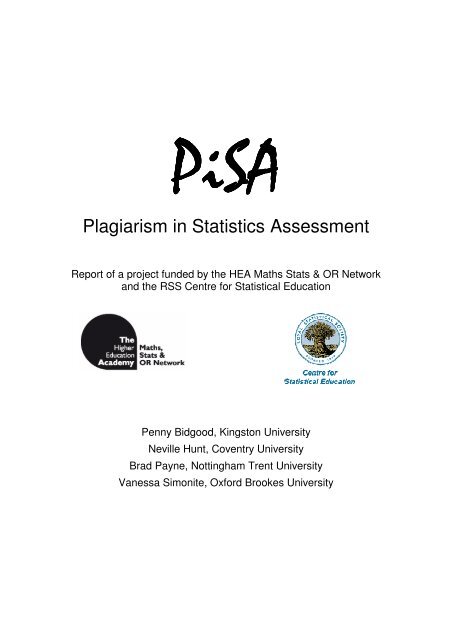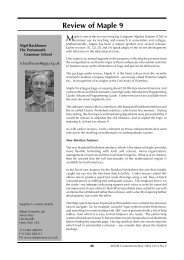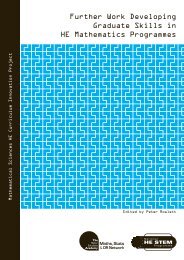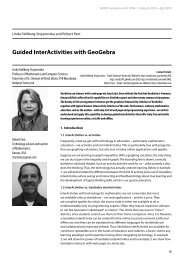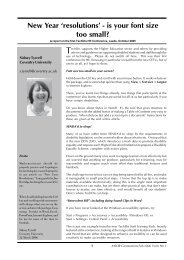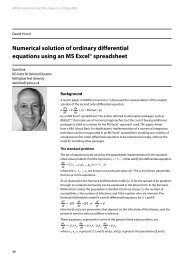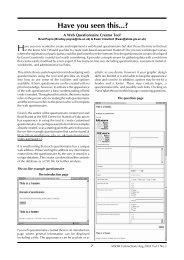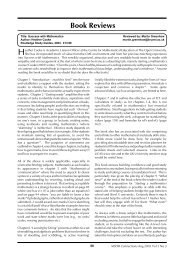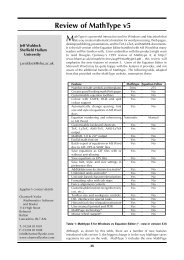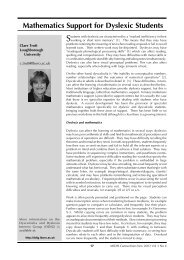(Plagiarism in Statistics Assessment) (PDF) - PlagiarismAdvice
(Plagiarism in Statistics Assessment) (PDF) - PlagiarismAdvice
(Plagiarism in Statistics Assessment) (PDF) - PlagiarismAdvice
You also want an ePaper? Increase the reach of your titles
YUMPU automatically turns print PDFs into web optimized ePapers that Google loves.
PiSA<br />
PiSA<br />
<strong>Plagiarism</strong> <strong>in</strong> <strong>Statistics</strong> <strong>Assessment</strong><br />
Report of a project funded by the HEA Maths Stats & OR Network<br />
and the RSS Centre for Statistical Education<br />
Penny Bidgood, K<strong>in</strong>gston University<br />
Neville Hunt, Coventry University<br />
Brad Payne, Nott<strong>in</strong>gham Trent University<br />
Vanessa Simonite, Oxford Brookes University
PiSA- <strong>Plagiarism</strong> <strong>in</strong> <strong>Statistics</strong> <strong>Assessment</strong><br />
F<strong>in</strong>al Draft Project Report<br />
1 Introduction<br />
There is much concern <strong>in</strong> British Higher Education Institutions that <strong>in</strong>stances of plagiarism<br />
are on the <strong>in</strong>crease. Forms of assessment such as the traditional exam<strong>in</strong>ation and on-l<strong>in</strong>e<br />
test<strong>in</strong>g us<strong>in</strong>g large question banks and randomly created tests are the least vulnerable to<br />
academic misconduct, but these types of test<strong>in</strong>g fail to address some important learn<strong>in</strong>g<br />
outcomes <strong>in</strong> <strong>Statistics</strong>, not least the ability of students to analyse a set of data<br />
appropriately and report results effectively without very limit<strong>in</strong>g time constra<strong>in</strong>ts. However,<br />
the lack of supervision associated with coursework assignments means that giv<strong>in</strong>g<br />
students the same data to analyse poses a serious risk of plagiarism, either <strong>in</strong> the<br />
analysis, or <strong>in</strong> the report<strong>in</strong>g. Group work, which is used to give students opportunities to<br />
develop team skills, has its own plagiarism problems.<br />
The RSS Centre for Statistical Education and the MSOR Network jo<strong>in</strong>tly funded the<br />
<strong>Plagiarism</strong> <strong>in</strong> <strong>Statistics</strong> <strong>Assessment</strong> (PiSA) project, which aimed:<br />
1. to survey HE lecturers <strong>in</strong> <strong>Statistics</strong> to f<strong>in</strong>d out what methods of assessment and<br />
strategies to deter plagiarism are be<strong>in</strong>g employed currently;<br />
2. to identify and synthesise elements of good practice;<br />
3. to dissem<strong>in</strong>ate f<strong>in</strong>d<strong>in</strong>gs widely.<br />
The project team comprised Penny Bidgood (K<strong>in</strong>gston), Neville Hunt (Coventry), Brad<br />
Payne (Nott<strong>in</strong>gham Trent) and Vanessa Simonite (Oxford-Brookes). A copy of the survey<br />
proforma may be found <strong>in</strong> Appendix 1.<br />
In gather<strong>in</strong>g evidence the project team made no attempt to take a random sample of<br />
<strong>Statistics</strong> lecturers. First, the choice of universities surveyed was by geographical<br />
cluster<strong>in</strong>g, constra<strong>in</strong>ed by very limited fund<strong>in</strong>g. Second, participation by lecturers was<br />
entirely voluntary. S<strong>in</strong>ce the project did not aim to assess the extent of plagiarism this<br />
should not matter. The aim was to f<strong>in</strong>d out about good practice <strong>in</strong> deterr<strong>in</strong>g plagiarism and<br />
it is reasonable to assume that those with good ideas were more than happy to disclose<br />
them. Although some take the view that lecturers are there to teach and not to police, the<br />
majority of those surveyed seemed highly aware of the plagiarism issue and were tak<strong>in</strong>g<br />
action, however small, to combat it. However, it is possible that others who refused to<br />
participate <strong>in</strong> the survey are “<strong>in</strong> denial” and do<strong>in</strong>g very little.<br />
Despite the problems, many lecturers felt that the practice of <strong>Statistics</strong> <strong>in</strong> both service and<br />
specialist modules should <strong>in</strong>volve coursework, reflect<strong>in</strong>g the applied nature of the<br />
discipl<strong>in</strong>e. Modules where over 40% of the assessment used coursework of this nature<br />
were not uncommon. Typical “take-home” assignments consist of analys<strong>in</strong>g data and<br />
writ<strong>in</strong>g a report on the f<strong>in</strong>d<strong>in</strong>gs, sometimes <strong>in</strong>volv<strong>in</strong>g group work. The project focused on<br />
those forms of plagiarism that arise most commonly <strong>in</strong> <strong>Statistics</strong> assessment and were<br />
mentioned by lecturers <strong>in</strong> <strong>in</strong>terviews or emails. The forms of academic misconduct<br />
mentioned most often were copy<strong>in</strong>g and collusion. Data fabrication was mentioned <strong>in</strong> the<br />
context of some assignments and failure to acknowledge sources arose <strong>in</strong> the context of<br />
project work.<br />
PISA Project 1 2007
2 Summary of Project Activities<br />
a. A website for the project was established at:<br />
http://mathstore.gla.ac.uk/cms/<strong>in</strong>dex.asp?recno=60<br />
<strong>in</strong>clud<strong>in</strong>g a facility for staff and students to express their views.<br />
b. A Jiscmail discussion list was created at:<br />
http://www.jiscmail.ac.uk/lists/pisa.html<br />
c. A member of the project team attended a workshop at Coventry University on<br />
“Deterr<strong>in</strong>g, detect<strong>in</strong>g & deal<strong>in</strong>g with plagiarism” given by Jude Carroll of Oxford<br />
Brookes University <strong>in</strong> January 2007.<br />
d. A member of the project team attended the Netskills workshop on “Detect<strong>in</strong>g and<br />
Deterr<strong>in</strong>g <strong>Plagiarism</strong>” at Oxford <strong>in</strong> February 2007.<br />
e. A survey was conducted by a comb<strong>in</strong>ation of telephone, email and personal contact<br />
of 50 members of staff at the follow<strong>in</strong>g 23 universities: Aston, Birm<strong>in</strong>gham,<br />
Brighton, Bristol, Cardiff, Chichester, Coventry, Derby, Glasgow, Hertfordshire,<br />
K<strong>in</strong>gston, Loughborough, Middlesex, Northumbria, Nott<strong>in</strong>gham Trent, Oxford<br />
Brookes, Read<strong>in</strong>g, Royal Holloway, Sheffield, Surrey, UCL, Warwick, and<br />
Wolverhampton.<br />
Information on assessment and associated plagiarism issues was gathered on a<br />
total of 96 taught modules. The breakdown by subject discipl<strong>in</strong>e was as follows:<br />
Discipl<strong>in</strong>e Number of<br />
modules<br />
Maths/<strong>Statistics</strong> 53<br />
Bus<strong>in</strong>ess/Economics 26<br />
Health Sciences 8<br />
Psychology 6<br />
Biosciences 2<br />
Other 1<br />
f. Details of the project were publicised on the allstat mail<strong>in</strong>g list, <strong>in</strong> RSS News and <strong>in</strong><br />
the MSOR Connections newsletter. Information about the project was also<br />
circulated by email to HEA subject networks <strong>in</strong> Bus<strong>in</strong>ess, Economics, Psychology,<br />
Geography, Biosciences and Health.<br />
g. A presentation was given at the ASLU conference <strong>in</strong> London, May 2007.<br />
h. A poster presentation of the project was presented at the ISI/IASE Conference on<br />
Assess<strong>in</strong>g Student Learn<strong>in</strong>g <strong>in</strong> <strong>Statistics</strong> <strong>in</strong> Guimarães, Portugal <strong>in</strong> August 2007.<br />
i. A f<strong>in</strong>al report on the project was given at the CETL/MSOR Conference at<br />
Birm<strong>in</strong>gham University <strong>in</strong> September 2007.<br />
j. A copy of the f<strong>in</strong>al report has been circulated to each lecturer contacted <strong>in</strong> the<br />
survey, as a matter of courtesy.<br />
PISA Project 2 2007
3 General plagiarism issues<br />
3.1 Large numbers<br />
It seems likely that the growth <strong>in</strong> academic misconduct has gone hand <strong>in</strong> hand with the<br />
growth <strong>in</strong> student numbers. As a student, if you are 1 among 10 you probably th<strong>in</strong>k twice<br />
before copy<strong>in</strong>g from your classmate, but if you are 1 among 500 you must rate your<br />
chances of be<strong>in</strong>g caught as very small <strong>in</strong>deed. Also, <strong>in</strong> a class of 10 you would expect to<br />
know the lecturer personally so that any plagiarism offence would be very embarrass<strong>in</strong>g to<br />
all concerned, whereas <strong>in</strong> a class of 500 the lecturer is unlikely to be able to put a face to<br />
the name. In fact with anonymous mark<strong>in</strong>g the lecturer may only report to an adm<strong>in</strong>istrator<br />
that he believes student 4126 has copied from student 7519!<br />
In this respect, across the sector, there does seem to be a marked difference between<br />
specialist <strong>Statistics</strong> courses, which are typically very small, and very large service modules<br />
for non-specialists. It is the latter that pose the greater challenge.<br />
3.2 <strong>Plagiarism</strong> <strong>in</strong> group work<br />
Many lecturers reported us<strong>in</strong>g group work <strong>in</strong> statistics assignments or project work. In<br />
order to reduce plagiarism and “piggy-back<strong>in</strong>g” it was usual to have small groups of 2 or 3<br />
students work<strong>in</strong>g together. Students often had to keep records of meet<strong>in</strong>gs and present<br />
their f<strong>in</strong>d<strong>in</strong>gs orally or <strong>in</strong> a poster presentation when they would have to answer questions<br />
on the work. In other cases, although students worked together they had to produce<br />
<strong>in</strong>dividual reports or were given a test at the conclusion of their work. The onus was on<br />
the students to identify non-contributors with<strong>in</strong> their group.<br />
3.3 Cheat<strong>in</strong>g by students whose first language is not English<br />
Many cases were reported where <strong>in</strong>ternational students were clearly employ<strong>in</strong>g the<br />
services of professionals/friends to either produce or polish their coursework for them.<br />
There may be a cultural element to this, where hand<strong>in</strong>g <strong>in</strong> a poorly written piece of work is<br />
considered to be unacceptable. Such students are typically at a disadvantage to their<br />
English peers with regards to report writ<strong>in</strong>g and presentations. Cases were reported of<br />
immaculate reports be<strong>in</strong>g submitted by students who were unable to construct mean<strong>in</strong>gful<br />
sentences throughout the course. There is no suggestion that <strong>in</strong>ternational students are<br />
more likely to plagiarise, simply that they are more likely to be detected.<br />
3.4 Onl<strong>in</strong>e-cheat<strong>in</strong>g companies<br />
On-l<strong>in</strong>e cheat<strong>in</strong>g companies provide coursework and dissertation writ<strong>in</strong>g services at a<br />
range of costs depend<strong>in</strong>g on the quality, length and urgency of the work. An example of<br />
such a company is Elizabeth Hall Associates whose website (www.elizabethhall.com)<br />
quite openly boasts:<br />
We give you: <strong>Plagiarism</strong> proof scripts. Unique, customised writ<strong>in</strong>g prepared for you<br />
to your specifications. We never re-use work, the copyright is yours. We do not<br />
need to offer you a payment guarantee of ‘£1000 if caught’ – we know if you are<br />
caught you lose your degree. In ten years our work has never been detected.<br />
Nowadays these companies offer far more than onl<strong>in</strong>e essay banks. Typically they<br />
employ a panel of experts <strong>in</strong> all k<strong>in</strong>ds of discipl<strong>in</strong>es, who will effectively act as consultants<br />
to students who need help with their assignments. The project team considered<br />
PISA Project 3 2007
employ<strong>in</strong>g one of these onl<strong>in</strong>e services <strong>in</strong> order to assess the quality of the work supplied,<br />
but it was felt to be ethically untenable to spend project funds <strong>in</strong> this way.<br />
The extent to which these types of services are utilised by <strong>Statistics</strong> students is unknown.<br />
However such services cannot be trusted to provide a unique piece of coursework. A case<br />
was encountered where identical coursework had been submitted by two students who<br />
had never met each other. When questioned they admitted that they had both<br />
<strong>in</strong>dependently used such a service but thought that they were purchas<strong>in</strong>g a personalised<br />
piece of work. Ironically they felt cheated by the company!<br />
4 Deterr<strong>in</strong>g <strong>Plagiarism</strong><br />
4.1 Dissem<strong>in</strong>ation and enforcement of <strong>in</strong>stitutional procedures<br />
The publication of <strong>in</strong>stitutional procedures can be valuable both <strong>in</strong> <strong>in</strong>form<strong>in</strong>g students<br />
about what is and is not acceptable and as a strong deterrent to plagiarism. Appendix 2<br />
gives an extract from a student handbook issued to <strong>Statistics</strong> students at University<br />
College London, which gives clear examples of the plagiarism committed by students and<br />
the penalties that were applied. Several lecturers said it was their policy to tell students<br />
about cases that had been prosecuted <strong>in</strong> previous years.<br />
A lecturer at Middlesex University uses “early <strong>in</strong>tervention” to prevent plagiarism. Here,<br />
students are given a small task, worth about 10% of the total assessment, early <strong>in</strong> the<br />
module. This is marked and any copy<strong>in</strong>g or collusion is identified and discussed with the<br />
students concerned. Students who are likely to collaborate are thereby identified early and<br />
dealt with before it becomes a major issue.<br />
Many universities require students hand<strong>in</strong>g <strong>in</strong> coursework to sign a declaration that they<br />
have read and understood the relevant regulations and are submitt<strong>in</strong>g work that is entirely<br />
their own. While this does not <strong>in</strong> itself elim<strong>in</strong>ate plagiarism, it may act as a deterrent and<br />
hav<strong>in</strong>g the declaration does at least make pleas of ignorance untenable.<br />
S<strong>in</strong>ce assessment is a key element <strong>in</strong> the role of a lecturer it was surpris<strong>in</strong>g to encounter<br />
lecturers who were unfamiliar with their university’s policy on cheat<strong>in</strong>g. Several lecturers<br />
reported that they had found copy<strong>in</strong>g or collusion and dealt with it <strong>in</strong>formally by warn<strong>in</strong>g<br />
students aga<strong>in</strong>st future misconduct. A difficulty with an <strong>in</strong>formal warn<strong>in</strong>g is that it may not<br />
be sufficient to deter some students from future academic misconduct. It was also felt that<br />
it depended on the amount of plagiarism. Just a sentence or two <strong>in</strong> a first year coursework<br />
might be dealt with by the lecturer discuss<strong>in</strong>g this with a student, whereas copy<strong>in</strong>g from<br />
published articles would br<strong>in</strong>g the University procedures <strong>in</strong>to action. Another lecturer said<br />
that he kept th<strong>in</strong>gs “low-key” <strong>in</strong> the first year and did not go through the rigorous academic<br />
procedures, except <strong>in</strong> very serious cases. This apparently widespread <strong>in</strong>formal approach<br />
to plagiarism is worry<strong>in</strong>g. Where there is <strong>in</strong>consistency and a patent reluctance among<br />
staff to prosecute plagiarism offences, students will be quick to capitalise on it.<br />
It seems to be generally accepted that if formal discipl<strong>in</strong>ary procedures are clear,<br />
consistently applied, with a graduated scale of penalties, and with m<strong>in</strong>imal bureaucracy,<br />
then staff will be <strong>in</strong>cl<strong>in</strong>ed to apply them and students will <strong>in</strong> turn be <strong>in</strong>cl<strong>in</strong>ed not to breach<br />
them.<br />
PISA Project 4 2007
4.2 Us<strong>in</strong>g headers and footers as a simple deterrent<br />
One lecturer required students to <strong>in</strong>clude their student ID number both <strong>in</strong> the header of<br />
every page of their word-processed reports and also with<strong>in</strong> the names of the variables<br />
used <strong>in</strong> their analysis. Another reported that the software used by the students<br />
automatically time-stamped the plots produced. Yet another <strong>in</strong>sisted that the student’s<br />
name and ID number appeared as a caption <strong>in</strong>side every graph produced. These simple<br />
ideas aim to prevent students from simply hand<strong>in</strong>g <strong>in</strong> a photocopy (or doctored photocopy)<br />
of a fellow-student’s work. Even if a student has access to their friend’s electronic<br />
document some very careful edit<strong>in</strong>g would be needed to correct every <strong>in</strong>stance of their<br />
friend’s ID.<br />
Another respondent said that they <strong>in</strong>sisted students number the pages of any submission<br />
<strong>in</strong> the format “page x of y” so that they could not produce an additional sheet at a later<br />
stage compla<strong>in</strong><strong>in</strong>g that the lecturer must have mislaid it!<br />
4.3 Organisation of mark<strong>in</strong>g<br />
Organisation of the mark<strong>in</strong>g of assignments is an important issue. As mentioned earlier,<br />
<strong>Statistics</strong> classes tend to be either very large <strong>in</strong> service courses or very small <strong>in</strong> specialist<br />
groups. Assignments from the latter can easily be marked by one person but the former<br />
often <strong>in</strong>volve an army of research students. In some universities the students on a module<br />
are spread over several different campuses and, with modern communications, there is<br />
scope for <strong>in</strong>ter-campus plagiarism.<br />
Ideally all students’ work should be marked by the same person so that any collusion is<br />
likely to be noticed. However, with large classes and an <strong>in</strong>creas<strong>in</strong>g pressure on staff to<br />
give prompt feedback, this is often not feasible. One respondent reported that this was the<br />
prime reason for switch<strong>in</strong>g to assessment by supervised tests. One solution might be for<br />
different markers to each assess one part of all students’ work. If there are multiple<br />
markers one possibility is to allocate mark<strong>in</strong>g at random to markers, rather than by tutorial<br />
group. This avoids giv<strong>in</strong>g colluders the safe option of copy<strong>in</strong>g the work of someone <strong>in</strong> a<br />
different group, although some <strong>in</strong>tra-group collusion might then go undetected. On the<br />
other hand one respondent thought there was educational benefit <strong>in</strong> students’ work be<strong>in</strong>g<br />
marked by their own tutor, so that the student would feel comfortable about query<strong>in</strong>g any<br />
comments made. One lecturer with a group of about 350 students randomly selects<br />
pieces of coursework from each tutor to double mark. This not only acts as a deterrent to<br />
plagiarism but helps also to ensure consistency of mark<strong>in</strong>g.<br />
Bizarrely it is quite common for people who have colluded to hand their work <strong>in</strong> at the<br />
same time, perhaps on the assumption that the scripts will be sorted <strong>in</strong> some way before<br />
mark<strong>in</strong>g. One lecturer reported a case where three students who submitted their work late<br />
– and hence were likely to be marked together - had exactly the same errors.<br />
Many lecturers reported that they did not perceive plagiarism as a problem s<strong>in</strong>ce they<br />
taught small groups, knew their students well, marked all the work themselves and hence<br />
would be able to detect collusion and copy<strong>in</strong>g quickly. One lecturer always required<br />
students to submit a report and felt that she could always spot similar phras<strong>in</strong>g and<br />
spell<strong>in</strong>g. Another thought that plagiarism was possible <strong>in</strong> his first year module, but that he<br />
would be able to judge from the <strong>in</strong>terpretation students gave to their results and the way <strong>in</strong><br />
which they phrased these, whether they had cheated or not. Two respondents said that<br />
they looked especially closely at work submitted by students who ga<strong>in</strong>ed very good<br />
coursework marks but did badly <strong>in</strong> tests.<br />
PISA Project 5 2007
4.4 Us<strong>in</strong>g supervision to validate coursework assessments<br />
As a response to plagiarism problems several lecturers reported a move away from takehome<br />
assignments towards supervised “hands-on” practical assessment <strong>in</strong> a computer<br />
laboratory. Typically the student is given a data set and a sheet of accompany<strong>in</strong>g<br />
questions which require some form of calculation or analysis us<strong>in</strong>g a specific computer<br />
package. The computers are monitored to ensure that no other software (e.g. email or<br />
web-browser) are accessed. In some cases the student produces hand-written answers,<br />
sketch<strong>in</strong>g any necessary diagrams or charts. Other lecturers require students to submit<br />
their solutions electronically or to send their output to a secure pr<strong>in</strong>ter. One lecturer<br />
reported that feedback from students on this approach had been positive - “Work<strong>in</strong>g under<br />
pressure is what got me my job”.<br />
Chris Dracup at Northumbria University used to set assignments for which each student<br />
received a random sample of some greater population of data. More recently he has<br />
adopted the approach of a seen exam<strong>in</strong>ation rather than an assignment. One week before<br />
the exam<strong>in</strong>ation students are given a numerical question with a small amount of data - just<br />
to illustrate the nature of the data and their layout. In the exam<strong>in</strong>ation proper they receive<br />
the full data set (which will be common to all the candidates). Students are given access<br />
to SPSS (but no other software) and are required to decide what analysis to perform, and<br />
to carry it out. Questions (two on a paper) require students to expla<strong>in</strong> their choice of test,<br />
briefly describe their SPSS commands, report summary statistics, and draw appropriate<br />
conclusions. Their answers are written by hand <strong>in</strong> the usual exam<strong>in</strong>ation answer booklets.<br />
Chris reports that this saves a good deal of time and does not seem to have <strong>in</strong>creased<br />
student assessment anxiety too much. Clearly, it does not stop students from discuss<strong>in</strong>g<br />
what they th<strong>in</strong>k is an appropriate analysis - but it does ensure that the analysis they<br />
present is their own work.<br />
Several variations on this approach were reported by others. Some lecturers issue a<br />
published paper for students to review <strong>in</strong> advance of an exam<strong>in</strong>ation <strong>in</strong> which at least one<br />
question relates to the paper. Another lecturer issues students with case studies<br />
throughout the year, which they are free to discuss with each other, but the assessment on<br />
the case studies is <strong>in</strong> the form of a supervised test.<br />
Reza Oskrochi at Oxford Brookes sets students <strong>in</strong> an advanced statistics module a<br />
coursework assignment <strong>in</strong> which they analyse (the same) data and write a report. Each<br />
student gives a brief presentation to the assessor at which questions are asked and they<br />
may be required to replicate some of their analysis. The written report is marked on the<br />
spot. As with the above example, students can discuss the assignment with each other but<br />
must demonstrate that they personally have achieved the relevant learn<strong>in</strong>g outcomes<br />
dur<strong>in</strong>g their presentation. (A drawback to this approach, identified by Lorna Smith from<br />
James Watt College, is that students may protest that it is unfair on those whose oral skills<br />
let them down.)<br />
Some lecturers expressed concern about lax arrangements for supervised <strong>in</strong>-class tests.<br />
For example, due to resource constra<strong>in</strong>ts, tests often took place <strong>in</strong> crowded lecture<br />
theatres with too few <strong>in</strong>vigilators. Not only did this prevent adequate separation of<br />
students but it was impossible to move among the students to exam<strong>in</strong>e their ID cards or<br />
check for any unauthorised material <strong>in</strong> their possession. It was also reported that on large<br />
service modules the same test might be sat by different groups at different times, allow<strong>in</strong>g<br />
the possibility of <strong>in</strong>formation be<strong>in</strong>g passed from one group to another. At one university<br />
PISA Project 6 2007
the student record system could provide class lists show<strong>in</strong>g student photographs, which<br />
the lecturer could take to the test to check for impersonation. Several lecturers reported<br />
us<strong>in</strong>g multiple versions of a test <strong>in</strong> the same room, arranged <strong>in</strong> such a way that adjacent<br />
students were given different tests. For ease of adm<strong>in</strong>istration the different versions would<br />
normally be on different coloured paper. There was anecdotal evidence of a lecturer who<br />
used different coloured test papers as a distracter when <strong>in</strong> fact they were all identical!<br />
4.5 Individualised assessments<br />
Considerable effort is tak<strong>in</strong>g place among <strong>Statistics</strong> lecturers to develop ways of<br />
personalis<strong>in</strong>g assessments. Some of these methods are very simple; others highly<br />
technical and software dependent. Undoubtedly there is some duplication of effort.<br />
Several lecturers reported us<strong>in</strong>g the assessment tool with<strong>in</strong> their <strong>in</strong>stitution’s virtual<br />
learn<strong>in</strong>g environment (e.g. Blackboard) to create randomised computer-marked onl<strong>in</strong>e<br />
quizzes which students must complete on a regular basis. Although these were typically<br />
unsupervised, it was felt that each quiz carried such little weight <strong>in</strong> the overall assessment<br />
that the advantages ga<strong>in</strong>ed by student engagement outweighed any possible risk of<br />
collusion. Although this type of assessment fails to address some important learn<strong>in</strong>g<br />
outcomes for <strong>Statistics</strong> students, it was seen as a pragmatic response to very large class<br />
sizes.<br />
Liz Moores at Aston University goes to the trouble of creat<strong>in</strong>g sets of different multiple<br />
choice questions each shar<strong>in</strong>g the same list of possible numerical answers. A student<br />
who copies the answer from a neighbour is then later to be found protest<strong>in</strong>g of<br />
<strong>in</strong>consistency <strong>in</strong> the mark<strong>in</strong>g – they were marked wrong but their neighbour got full marks!<br />
Two lecturers reported us<strong>in</strong>g the ISCUS (Individualized <strong>Statistics</strong> Coursework Us<strong>in</strong>g<br />
Spreadsheets) tool developed at Coventry University. ISCUS enables a lecturer to create<br />
an assignment generator spreadsheet <strong>in</strong>to which students enter their ID number to obta<strong>in</strong><br />
data and/or tasks. Although the data is supplied <strong>in</strong> Microsoft Excel format there is noth<strong>in</strong>g<br />
to prevent students complet<strong>in</strong>g their analysis with<strong>in</strong> a different software package (e.g.<br />
M<strong>in</strong>itab).<br />
Mike Rosser at Coventry University employs a simple but highly effective method based<br />
on the digits of the student’s ID number. For example, if the last two digits are represented<br />
by X and Y, students might be asked to calculate a 9X% confidence <strong>in</strong>terval, or to exclude<br />
rows X and Y from a given dataset prior to their analysis.<br />
Use of the F<strong>in</strong>ancial Analysis Made Easy (FAME) public sector database is popular at<br />
Nott<strong>in</strong>gham Trent University <strong>in</strong> teach<strong>in</strong>g statistics on the Account<strong>in</strong>g and F<strong>in</strong>ance degree.<br />
FAME is a database that conta<strong>in</strong>s <strong>in</strong>formation for companies <strong>in</strong> the UK and Ireland. It<br />
conta<strong>in</strong>s <strong>in</strong>formation on 3.4 million companies, 2.4 million of which are <strong>in</strong> a detailed format.<br />
Students are allocated variables for two different contexts, where no two students have the<br />
same sets of variables. Mail-merge is used to construct the coursework for the 400+<br />
students which is then emailed to the students. Sem<strong>in</strong>ar tutors are also given paper<br />
copies. The important lesson to be learned is that courses of this nature evolve over time.<br />
It is not possible to ensure that each student’s coursework is of equal difficulty; however<br />
this is seen as an acceptable trade-off. S<strong>in</strong>ce the FAME database is updated cont<strong>in</strong>uously<br />
the teacher must ensure the variables used are valid each year.<br />
PISA Project 7 2007
Where a large data set is available, simple approaches can be used to provide <strong>in</strong>dividual<br />
assignments: V<strong>in</strong>ce Daly at K<strong>in</strong>gston advocates allocat<strong>in</strong>g each student a different country<br />
or a different pair of US States and requir<strong>in</strong>g them to collect their own data on a particular<br />
theme. Similarly, Vanessa Simonite at Oxford Brookes uses an assignment <strong>in</strong> which each<br />
student is asked to make comparisons between different sets of subgroups. This<br />
approach reta<strong>in</strong>s the feature of us<strong>in</strong>g real data.<br />
One lecturer reports sett<strong>in</strong>g a coursework assignment consist<strong>in</strong>g of a number of questions<br />
where the data for each question is randomly chosen from six available datasets.<br />
Students would have to go to some trouble to f<strong>in</strong>d someone with the same data for one<br />
question but the chances of f<strong>in</strong>d<strong>in</strong>g someone with the same data for all the questions is<br />
very small.<br />
One lecturer at Middlesex University makes students use the Simul8 software to simulate<br />
their personalised data, although the students f<strong>in</strong>d learn<strong>in</strong>g the software quite challeng<strong>in</strong>g.<br />
A difficulty with <strong>in</strong>dividualised assignments is that if different students have different<br />
answers, this can create extra work for the marker. Karen Ayres at Read<strong>in</strong>g University<br />
described a sophisticated program for generat<strong>in</strong>g and mark<strong>in</strong>g <strong>in</strong>dividualised problem<br />
sheets for students. While this prevented students be<strong>in</strong>g awarded marks for copy<strong>in</strong>g and<br />
was a deterrent to collusion, the assessment was found to use too much staff time, as it<br />
was felt unfair to award very low or zero marks to a student who made a mistake early <strong>in</strong> a<br />
problem but used correct methods subsequently though obta<strong>in</strong>ed <strong>in</strong>correct answers due to<br />
their error. To ensure that the marks were awarded <strong>in</strong> l<strong>in</strong>e with this approach staff needed<br />
to review students’ answers.<br />
Several lecturers have developed their own bespoke web-based facilities that generate<br />
random data, either real or simulated, based on a students’ ID number. Examples <strong>in</strong>clude:<br />
• Maggie Gale at Derby University gives all students the same assignment brief, namely<br />
a research scenario and associated research questions. She then uses an onl<strong>in</strong>e<br />
simulator which produces datasets based on the student’s University ID number. She<br />
has plans to develop the simulator further to make it a more generic tool.<br />
• Rudiger Schack and Laurence O’Toole at Royal Holloway have replaced traditional<br />
weekly M<strong>in</strong>itab exercise worksheets with <strong>in</strong>dividualised assessments. With some<br />
<strong>in</strong>telligent question design, they were able to (re)design every worksheet to ask for only<br />
numerical answers (<strong>in</strong>clud<strong>in</strong>g multiple choice questions). Thus, they were able to<br />
remove the paper element of submissions entirely by provid<strong>in</strong>g each student with a<br />
personalised HTML form. Several PERL scripts on the department server are used to<br />
process a student's answers <strong>in</strong> different ways. They can be marked <strong>in</strong>stantly (although<br />
currently they store these marks until the current deadl<strong>in</strong>e expires at the end of the<br />
week), and completely consistently with every other student. Partial marks can be<br />
given for answers numerically close to the correct answer, and marks can be awarded<br />
for <strong>in</strong>correct answers that are nonetheless consistent with earlier submitted wrong<br />
answers. Recently, they received the team award <strong>in</strong> the College's Teach<strong>in</strong>g Prize<br />
scheme for their work on this project.<br />
• At Nott<strong>in</strong>gham Trent University the DRUID (Dynamic Resources Us<strong>in</strong>g Interest<strong>in</strong>g<br />
Data) project allows a lecturer to generate a unique worksheet and data set for each<br />
student. Furthermore a solution sheet, with guided <strong>in</strong>structions, is generated for each<br />
worksheet. The worksheets and solution sheets are generic <strong>in</strong> that any statistical<br />
package may be used to perform the analysis. This facility is freely available for others<br />
to use.<br />
PISA Project 8 2007
A system described by Neil Spencer at the University of Hertfordshire has taken the idea<br />
of automatic mark<strong>in</strong>g one stage further. Individualised problems (same questions,<br />
different data) are automatically generated, <strong>in</strong> the form of spreadsheets, and emailed to<br />
students with<strong>in</strong> a virtual learn<strong>in</strong>g environment. The answers are all numeric or multiplechoice.<br />
Students complete their work on the spreadsheet and submit it via email. A<br />
mark<strong>in</strong>g program compares the students’ answers to the correct answers and to wrong<br />
answers that are produced if a ‘classic mistake’ has been made. The archive of classic<br />
mistakes allows partial marks to be given if a student makes an error but then uses the<br />
right method from that po<strong>in</strong>t onward. Marks and feedback are returned to the student<br />
automatically with<strong>in</strong> the VLE. This sophisticated mark<strong>in</strong>g program cont<strong>in</strong>ues to be<br />
developed as students are encouraged to discuss their (less than perfect) marks so that<br />
‘new errors’ can be built <strong>in</strong>to the program. A problem with spreadsheets is that formulae<br />
can be copied and this may mean that the benefit of <strong>in</strong>dividualised data might be lost, but<br />
this system has a design feature which takes this problem <strong>in</strong>to account.<br />
Some lecturers th<strong>in</strong>k that <strong>in</strong>dividualis<strong>in</strong>g assessments is unnecessarily complicated. They<br />
place little weight on the actual calculations <strong>in</strong>volved and much more on the <strong>in</strong>terpretation<br />
and constructive criticism of data/methodology. Alternatively some use data and tasks that<br />
are so “rich” that there is no good reason why two students should follow the same l<strong>in</strong>e of<br />
th<strong>in</strong>k<strong>in</strong>g or method of analysis. One lecturer reported that students may have shared SAS<br />
code <strong>in</strong> a data analysis assignment, but that this was not checked as the <strong>in</strong>terpretation of<br />
results was regarded as be<strong>in</strong>g of overrid<strong>in</strong>g importance. Several lecturers spoke of<br />
students’ discussions as beneficial, as long as they proceeded to write up the analysis<br />
<strong>in</strong>dependently. In other words, there were some elements of assignments, such as the<br />
selection of an appropriate technique, or the production of code, for which discussion was<br />
thought by some lecturers as be<strong>in</strong>g constructive, or at least less important.<br />
4.6 Student data collection<br />
A very popular technique is to require students to collect their own data, perhaps subject to<br />
a specified m<strong>in</strong>imum number of variables/cases. However, it is acknowledged that there is<br />
a real risk that a student will choose a dataset for which an analysis is already available,<br />
perhaps from the Internet, a textbook, or from a previous student.<br />
Some ideas to defend aga<strong>in</strong>st this are:<br />
• Well <strong>in</strong> advance of the submission date the students must <strong>in</strong>form the lecturer of the<br />
source of their data so that it can be checked for suitability.<br />
• Students are told that their data must be the most recently available set for that<br />
series. This means that they cannot use the data from someone <strong>in</strong> a previous year,<br />
although perhaps some of the background <strong>in</strong>formation could be copied from them.<br />
• Students are each allocated a particular periodical and told that their data/study<br />
must be drawn from any issue <strong>in</strong> the current year.<br />
• Students are each allocated a different broad topic area, e.g. unemployment.<br />
In a medical statistics module at K<strong>in</strong>gston University there is an <strong>in</strong>dividual assignment<br />
where students have to f<strong>in</strong>d their own example of a medical case study. No two students<br />
can have the same study, so there is little scope for cheat<strong>in</strong>g. At the same university, <strong>in</strong> a<br />
module on time series, students (<strong>in</strong> small groups) are required to f<strong>in</strong>d their own data from<br />
“Economagic”. Aga<strong>in</strong>, no two groups are allowed to use the same dataset. At Chichester<br />
University <strong>in</strong> a service module to Sports Science students (<strong>in</strong> groups) collect data on their<br />
own fellow students, e.g. on heart rates or use of supplements.<br />
PISA Project 9 2007
4.7 R<strong>in</strong>g<strong>in</strong>g the changes<br />
It is generally acknowledged that it is unwise to set the same assignment <strong>in</strong> consecutive<br />
years. Some lecturers set what is essentially the same assignment but which asks for the<br />
students’ work to be presented <strong>in</strong> a novel format.<br />
The use of a poster format for assess<strong>in</strong>g <strong>Statistics</strong> was cited by several of our<br />
respondents. The poster is typically produced by a group of students, with each group<br />
tackl<strong>in</strong>g a slightly different problem or dataset. However, each <strong>in</strong>dividual must be present<br />
to “defend” the poster at a special session when lecturers (and maybe fellow students)<br />
come to view it and <strong>in</strong>terrogate them about it<br />
One respondent requires a written report-style format every year but varies the “client”.<br />
One year the report must be written as a newspaper article, another year as a research<br />
paper, yet another year as a brief<strong>in</strong>g document for the local MP, and so on. It is<br />
immediately obvious when a student has copied from one of last year’s students!<br />
At some universities, exam<strong>in</strong>ation papers are re-used each year, albeit with tight security<br />
<strong>in</strong> place to ensure that exam<strong>in</strong>ation papers do not enter the public doma<strong>in</strong>. Apparently<br />
there is no evidence of plagiarism between years – <strong>in</strong> fact students persistently make the<br />
same sort of errors – and there has been no upward drift <strong>in</strong> the average marks obta<strong>in</strong>ed<br />
over the years. At other universities this approach is made impossible due to an openaccess<br />
policy regard<strong>in</strong>g exam<strong>in</strong>ation papers and scripts.<br />
4.8 Electronic submission<br />
Requir<strong>in</strong>g students to submit an assessment electronically opens up a number of<br />
possibilities for plagiarism check<strong>in</strong>g. Some lecturers scrut<strong>in</strong>ise the properties of each<br />
student’s file, which details the author and location of the file, together with the times of its<br />
creation, last modification and last access. These details commonly enable submissions<br />
from different students to be traced back to a common source, although more IT literate<br />
students are becom<strong>in</strong>g wise to these pitfalls. A particularly dubious phrase from a<br />
students’ work can be copied <strong>in</strong>to a web search eng<strong>in</strong>e such as Google to check whether it<br />
is drawn from a source on the Internet. Sophisticated plagiarism detection software may<br />
also be used. TURNITIN is the onl<strong>in</strong>e electronic plagiarism detection software<br />
recommended by JISC. At the time of writ<strong>in</strong>g it is be<strong>in</strong>g used <strong>in</strong> almost 90% of UK<br />
universities. The cost currently is approximately £5000 per annum for a university of<br />
10,000 students.<br />
Many respondents said they had heard of TURNITIN and were plann<strong>in</strong>g to use it <strong>in</strong> the<br />
future. Some were under the false impression that it only checked for Internet plagiarism<br />
and did not realise that it can be used to check for collusion with<strong>in</strong> a cohort or between<br />
cohorts. One lecturer expressed the view that although electronic detection was not <strong>in</strong><br />
itself very useful, the threat of it was an effective deterrent. Significantly one respondent<br />
<strong>in</strong>tended to <strong>in</strong>crease the weight<strong>in</strong>g of coursework <strong>in</strong> the light of TURNITIN, hav<strong>in</strong>g<br />
confidence <strong>in</strong> its deterrence effect. Another respondent said that they were not yet us<strong>in</strong>g<br />
TURNITIN because they do not have the regulations for electronic submission properly<br />
worked out at <strong>in</strong>stitutional level. They believed that there would be a need for regulations<br />
about storage of work for a specified period and feared that their IT systems would not be<br />
able to cope.<br />
PISA Project 10 2007
One of the problems with us<strong>in</strong>g TURNITIN for <strong>Statistics</strong> assessments is that students are<br />
encouraged by their lecturers to use standard forms of technical language <strong>in</strong> their<br />
report<strong>in</strong>g. For example, “the r-squared value shows that 53% of the variation <strong>in</strong> ..”. This<br />
means that almost every student will have a significant percentage of their work reported<br />
as plagiarism. With large classes the lecturer may have to set a threshold percentage<br />
similarity below which they do not bother to <strong>in</strong>vestigate.<br />
TURNITIN greatly assists those lecturers who like students to collect their own data for<br />
analysis. The fear is that students will simply download a ready-made analysis from the<br />
Internet or will use the work of a student from a previous cohort. Once TURNITIN has<br />
been used for several years any collusion between cohorts should be easily detected.<br />
One disadvantage of TURNITIN is that it cannot be used to check for similarities between<br />
different spreadsheet files. Some lecturers set assignments where students must<br />
construct a spreadsheet to perform certa<strong>in</strong> calculations or to build a model. Even if<br />
students submit their spreadsheets electronically it can be very difficult to detect<br />
similarities <strong>in</strong> their construction, particularly if they have been careful to use very different<br />
layout and formatt<strong>in</strong>g. This is an area where further development is needed.<br />
A specific example of us<strong>in</strong>g TURNITIN was provided by Rebecca Lees of K<strong>in</strong>gston<br />
University who teaches a module of 800 students spread over 4 campuses. In the<br />
previous year <strong>in</strong> a group assignment collusion had been detected between 21 submissions<br />
out of 104. (They were only detected because one lecturer marked all the reports and<br />
recognised similarities <strong>in</strong> several of them.) As the work was based on an Excel<br />
spreadsheet, the electronic copy of the work was easily shared, but this meant that only<br />
work where there was little or no modification could be detected. This year, us<strong>in</strong>g<br />
TURNITIN, only 9 out of 150 submissions showed significant similarity, and some of these<br />
were repeat offenders!<br />
4.9 Engagement<br />
The experiences of lecturers who teach on a variety of degree courses <strong>in</strong>dicated that<br />
engagement was a key issue, particularly when <strong>Statistics</strong> was not a core degree subject.<br />
A consensus viewpo<strong>in</strong>t was that if the students engaged with the assessment task,<br />
whatever form it took, the chances of cheat<strong>in</strong>g were reduced considerably. This <strong>in</strong>evitably<br />
<strong>in</strong>volves greater effort <strong>in</strong> the design and development of the assessment materials. To<br />
<strong>in</strong>crease engagement it was suggested that lecturers should be more dynamic and use a<br />
variety of assessment methods. It was felt this was not only good for students but also for<br />
staff.<br />
4.10 F<strong>in</strong>al Year projects<br />
Typically f<strong>in</strong>al year student projects are <strong>in</strong>dividual pieces of work which are considered to<br />
be the equivalent of one or two taught modules. Given this weight<strong>in</strong>g, the potential for<br />
plagiarism needs to be taken very seriously. At several universities, part of the project<br />
assessment is for “development” or “ability to progress the project along appropriate l<strong>in</strong>es”<br />
or “time management”, as judged by the project supervisor. Thus, <strong>in</strong> order to do well <strong>in</strong><br />
this section, students need to show progress <strong>in</strong> regular meet<strong>in</strong>gs with their supervisors.<br />
Further, <strong>in</strong> some universities each student is given a viva by their supervisor and at least<br />
one other member of staff, which has proved a useful way to detect plagiarism.<br />
PISA Project 11 2007
5 Key F<strong>in</strong>d<strong>in</strong>gs<br />
5.1 <strong>Plagiarism</strong>, or more specifically collusion, is a significant problem with<strong>in</strong> large<br />
<strong>Statistics</strong> service modules and all lecturers need to give serious attention to antiplagiarism<br />
assessment strategies.<br />
5.2 The majority of <strong>Statistics</strong> lecturers are well aware of plagiarism issues and are tak<strong>in</strong>g<br />
action, however small, to combat it.<br />
5.3 It is quite common for <strong>Statistics</strong> lecturers to fail to apply <strong>in</strong>stitutional procedures <strong>in</strong><br />
“m<strong>in</strong>or” cases of plagiarism. In contrast, some lecturers make every effort to<br />
demonstrate how the regulations and penalties might apply to <strong>Statistics</strong><br />
assessments, giv<strong>in</strong>g examples of cases detected <strong>in</strong> previous years.<br />
5.4 <strong>Plagiarism</strong> often goes undetected on large service modules due to a multiplicity of<br />
assessors. It is most likely to be detected when one person assesses all the<br />
students.<br />
5.5 There is much <strong>in</strong>novative work tak<strong>in</strong>g place <strong>in</strong> the area of <strong>in</strong>dividualised assessment,<br />
but also some duplication of effort. There is scope for a further project to synthesise<br />
best practice and make it available to the wider community, <strong>in</strong>clud<strong>in</strong>g those teach<strong>in</strong>g<br />
<strong>Statistics</strong> with<strong>in</strong> other discipl<strong>in</strong>es.<br />
5.6 <strong>Assessment</strong>s that require students to collect their own data, either <strong>in</strong>dividually or <strong>in</strong><br />
small groups, are widely employed. Lecturers use a variety of imag<strong>in</strong>ative strategies<br />
to try to m<strong>in</strong>imise collusion both with<strong>in</strong> and between cohorts.<br />
5.7 Many <strong>Statistics</strong> lecturers have moved away from take-home assignments to <strong>in</strong>-class<br />
supervised computer-based assessments, often based on a previously circulated<br />
data set, case study or research paper.<br />
5.8 In some universities, <strong>in</strong>-class tests are exposed to a high risk of cheat<strong>in</strong>g by<br />
unsuitable accommodation, <strong>in</strong>adequate <strong>in</strong>vigilation, failure to check student<br />
identities, and naïve organisation.<br />
5.9 The TURNITIN electronic plagiarism detection software is <strong>in</strong>creas<strong>in</strong>gly be<strong>in</strong>g used<br />
and is giv<strong>in</strong>g lecturers greater confidence <strong>in</strong> the <strong>in</strong>tegrity of their coursework<br />
assessments.<br />
5.10 In f<strong>in</strong>al year extended project assessments it is good practice to <strong>in</strong>clude an element<br />
that assesses the student’s work<strong>in</strong>g method and, ideally, an oral exam<strong>in</strong>ation to<br />
check that the project is genu<strong>in</strong>ely the student’s own work.<br />
5.11 Onl<strong>in</strong>e cheat<strong>in</strong>g companies openly offer an easily accessible, if expensive, way for<br />
students to obta<strong>in</strong> professional <strong>in</strong>dividual help with <strong>Statistics</strong> assignments.<br />
PISA Project 12 2007
Appendix 1 PISA Survey Form<br />
Interview conducted by How?<br />
University Department<br />
Lecturer Module title<br />
Year (1,2,3) Service (y/n)? No. students % Coursework<br />
What is the rationale beh<strong>in</strong>d the coursework<br />
weight<strong>in</strong>g on this module?<br />
Has it always had this weight<strong>in</strong>g?<br />
If not, why was it changed?<br />
Is there any move to change the weight<strong>in</strong>g <strong>in</strong> the<br />
near future and if so, why?<br />
Description of Coursework Element % Ind /<br />
Grp<br />
Personalised?<br />
No. of<br />
Markers<br />
Elec<br />
Sub?<br />
Cheat<strong>in</strong>g an issue?<br />
(explore overleaf)<br />
PISA Project 13 2007
Coursework Element Discussion of cheat<strong>in</strong>g issues or anti-cheat<strong>in</strong>g strategy<br />
Other comments<br />
PISA Project 14 2007
Appendix 2 Example of Advice to Students<br />
Below is an edited extract of the advice provided to students by the Department of Statistical<br />
Science, University College London, for the 2007/8 academic year (supplied by Richard Chandler).<br />
PLAGIARISM AND COLLUSION<br />
<strong>Plagiarism</strong> means attempt<strong>in</strong>g to pass off someone else's work as your own, while collusion means<br />
pass<strong>in</strong>g off jo<strong>in</strong>t work as your own unaided effort. Both are unacceptable, <strong>in</strong> particular, <strong>in</strong> material<br />
submitted for exam<strong>in</strong>ation purposes <strong>in</strong>clud<strong>in</strong>g exercises done <strong>in</strong> your own time for <strong>in</strong>-course<br />
assessment. <strong>Plagiarism</strong> and collusion are regarded by the College as exam<strong>in</strong>ation irregularities<br />
(i.e. cheat<strong>in</strong>g) and are taken extremely seriously. UCL has now signed up to use a sophisticated<br />
detection system (Turn-It-In ® ) to scan work for evidence of plagiarism and collusion, and the<br />
Department reserves the right to use this for assessed coursework. This system gives access to<br />
billions of sources worldwide, <strong>in</strong>clud<strong>in</strong>g websites and journals, as well as other work submitted to<br />
the Department, UCL and other universities. It is therefore able to detect similarities between<br />
scripts that <strong>in</strong>dicate unacceptable levels of collusion, as well as material taken from other sources<br />
without attribution.<br />
What isn't acceptable?<br />
Students sometimes f<strong>in</strong>d it difficult to know what counts as plagiarism or collusion. The follow<strong>in</strong>g<br />
list is not exhaustive, but gives some <strong>in</strong>dication of what to avoid. It is based on guidel<strong>in</strong>es<br />
developed by Nick Hayes of the UCL Pharmacology Department. You may NOT:<br />
• Create a piece of work by cutt<strong>in</strong>g and past<strong>in</strong>g material from other sources (<strong>in</strong>clud<strong>in</strong>g<br />
web sites, books, lecture notes and other students' work).<br />
• Use someone else's work as your own. This <strong>in</strong>cludes, but is not limited to:<br />
- Mak<strong>in</strong>g notes while discuss<strong>in</strong>g an assessment with a friend, and subsequently us<strong>in</strong>g<br />
these as the basis for all or part of your submission.<br />
- Phon<strong>in</strong>g another student to discuss how best to carry out a particular piece of<br />
analysis.<br />
- Employ<strong>in</strong>g a professional ghostwrit<strong>in</strong>g firm or anyone else to produce work for you.<br />
• Use somebody else's ideas <strong>in</strong> your work without cit<strong>in</strong>g them.<br />
• Ask a lecturer <strong>in</strong> the department for help with assessed work, unless you make it clear<br />
to them that the work is assessed.<br />
• Help another student with their assessed work. If you do this, you will be deemed to be<br />
guilty of an exam<strong>in</strong>ation irregularity.<br />
What is acceptable?<br />
The follow<strong>in</strong>g practices do not constitute plagiarism / collusion:<br />
• Quot<strong>in</strong>g from other people's work, with the source (e.g. book, lecture notes, web site) clearly<br />
identified and the quotation enclosed <strong>in</strong> quotation marks.<br />
• Summaris<strong>in</strong>g or paraphras<strong>in</strong>g other people's work, provid<strong>in</strong>g they are acknowledged as the<br />
source of the ideas (aga<strong>in</strong>, usually this will be via a reference to the book, journal or web site<br />
from which the <strong>in</strong>formation was obta<strong>in</strong>ed).<br />
• Ask<strong>in</strong>g the course lecturer for help with difficult material, provid<strong>in</strong>g it is clear that the question is<br />
<strong>in</strong> connection with the assessment. The lecturer will be able to judge for him or herself what is<br />
an appropriate level of assistance.<br />
PISA Project 15 2007
Some examples<br />
[Examples deleted here for confidentiality reasons]<br />
How to avoid plagiarism and collusion<br />
If you are found to have committed an offence of plagiarism / collusion, it makes no difference<br />
whether or not you <strong>in</strong>tended to do so. Ignorance is no excuse. To avoid committ<strong>in</strong>g an offence, a<br />
useful rule of thumb is: if <strong>in</strong> doubt, don't do it. Make sure that any work you submit is your own<br />
unaided effort. More specific guidance is as follows:<br />
• Plan your work schedule carefully, to allow enough time to complete each piece of<br />
assessment.<br />
• If you do have genu<strong>in</strong>e problems <strong>in</strong> meet<strong>in</strong>g a deadl<strong>in</strong>e, don't take the easy way out and<br />
borrow a friend's work. Discuss your difficulty with the course lecturer <strong>in</strong> the first <strong>in</strong>stance.<br />
• If you are stuck with an assessment, don't ask another student for help. Discuss it with the<br />
course lecturer.<br />
• If another student asks you for help with an assessment, or asks to see your work, suggest that<br />
they approach the course lecturer <strong>in</strong>stead. Remember: if somebody else copies or uses your<br />
work, you will be penalised as well, even if you didn't expect them to use your work <strong>in</strong> this way.<br />
PISA Project 16 2007


